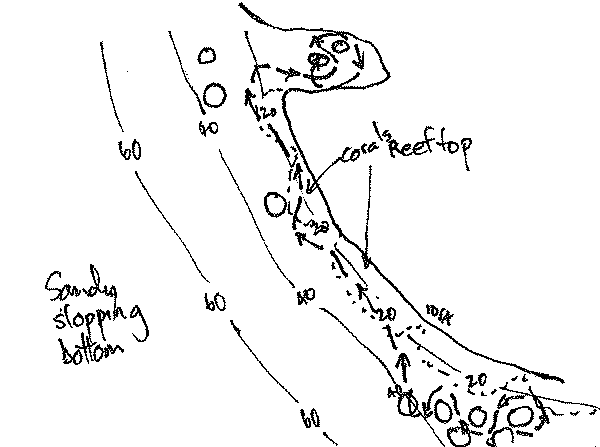|
Heron Bommie (also called The Bommie) is one of the best dive sites on the Great Barrier Reef, located just to the north of the entrance to the small harbour at Heron Island. As such, it is the closest dive site and one that is often dived for night dives. On my trip there in June 1989 and later in October 1989 for the Heron Island Dive Festival, I dived this site four times, including a night dive. You can also do it s a drift dive. It is only two minutes run in the boat to this site.
Most of the dives at Heron Island are (used to be?) drift dives. Basically you start at one mooring and the boat moves to another one (sometimes two or more sites along) and ties up to that mooring. You drift along in the tidal current and when you pass each mooring you check to see whether the boat is there. If not, you keep going till you reach the correct one.
Pams Point is the next dive site along from Heron Bommie. You can do the dive in either direction, although I did it from Heron Bommie to Pams Point.
Heron Bommie consists of a series of four large coral bommies that are located just off the main fringing reef and which run in a roughly straight line from south-east to north-west. There are also (I think), two smaller bommies near them.
 |
A very rough map I drew of Heron Bommie to Pams Point in 1989
Note depths are in feet - Heron Bommie is bottom |
In 1989 there was a mooring located adjacent to or on the south-eastern-most bommie. This had a depth of (I think) about five metres at the top and about 10 to 12 metres on the bottom. After descending the mooring, we normally headed north-west past the next bommie (bottom about 15 metres or so) and then parallel to the fringing reef in a roughly northerly direction. The depth along here is about nine metres at the bottom of the reef and slopes away to over 18 metres about 30 metres off the wall.
The bottom consists of a sandy slope with coral pieces and small coral bommies in spots. Once you get within site of the wall you should be at about 10 metres or so. You can either stay at this depth or go right to the wall at about six metres. Along this section you should see some white-tipped reef sharks and huge Queensland gropers.
The wall curves a bit to the right and about two thirds of the way to Pams Point you will see a bommie off the wall. This can have some interesting marine life in and on it.
Further on you will see that the main wall goes to the right and a small bay is created. This is near two bommies that are about 9 to 12 metres deep at the bottom. This area is Pams Point. In the bay there are a couple of small bommies and there is a mooring on one. You can spend some time exploring this bay and the bommies in front of the bay.
You should see lots of damsels, firefish, flutemouths, wrasse and batfish on this dive, as well as turtles. I also say the island's semi-submersible pass by and we waved to the people sitting inside it.
A pretty good dive.
Note this article was written in 2008 so my memory may be a bit out with some aspects of the dive site and things may have changed in the almost 20 years since I last dived there.
| 
 v6.00.307 © 2003-2005
v6.00.307 © 2003-2005